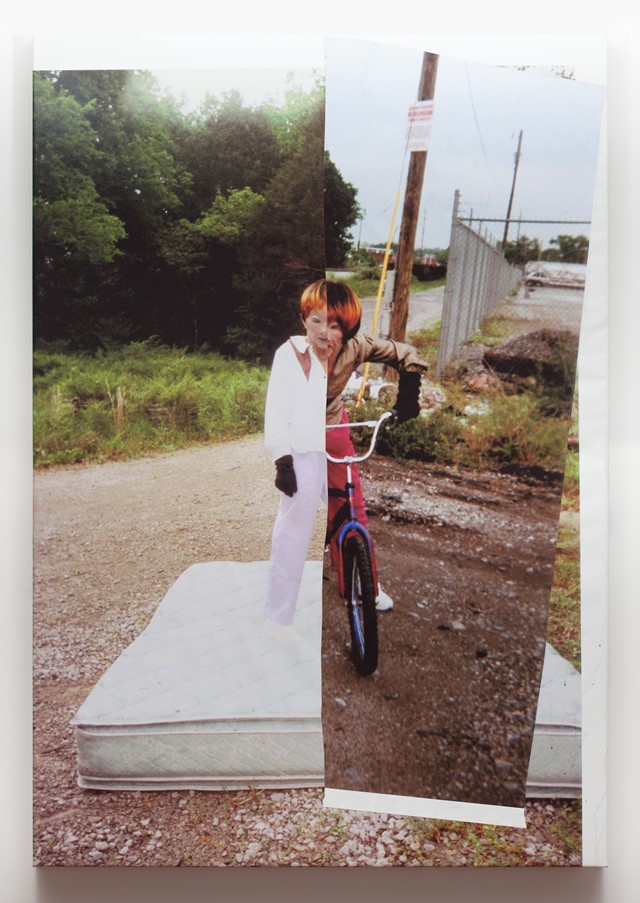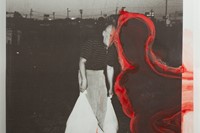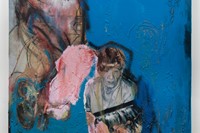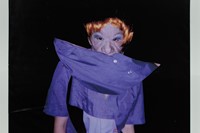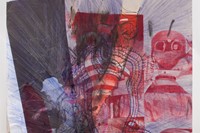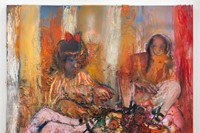Shadow Fux, the current exhibition at the Swiss Institute Contemporary Art in New York, is a collaboration between director Harmony Korine and artist Rita Ackermann. Featuring large-scale works on vinyl and canvas, the pair have made collages,
Shadow Fux, the current exhibition at the Swiss Institute Contemporary Art in New York, is a collaboration between director Harmony Korine and artist Rita Ackermann. Featuring large-scale works on vinyl and canvas, the pair have made collages, paintings, and drawn over stills from Korine’s 2009 film, Trash Humpers, using the film’s freakish, eerie characters as a narrative starting point. The exhibition also features a film by Korine, comprised of transmuted edits from Trash Humpers. We sat down with Korine and Ackermann to talk about the vision behind these haunting images.
What was the genesis of the idea for the collaboration?
Korine: Rita and I have known each other for years, since we were in our twenties. We’ve always messed around and collaborated informally, on drawings and paintings, jokes, stories – things like that. But summer 2009 was the first time we talked about doing an official collaboration, about making big, strange paintings based on these photos I had taken – to totally destroy the images and create something new with the ashes.
These were photographs that pre-dated Trash Humpers, correct?
Korine: Yeah, some of the original images in the show are stills from Trash Humpers, and some are actually photographs that served as inspiration for the film. I made these really crude masks that resemble burn victims – faces that were sort of melting – and my friends and I would go out wearing them late at night in the back alleyways near my house. We’d fool around and I’d take pictures using bad disposable cameras. I didn’t really know what I was doing; I was just trying something out. But when I looked at the images all together there was something interesting there. It felt like found footage, a found object – the sort of thing you’d find buried in the dirt in a zip-lock bag, or shoved up the guts of a horse.
Ackermann: The photographs felt very painterly to me, which made it really easy for me to work with the imagery. They have the quality of early expressionist paintings, yet so brutal at the same time – a kind of brutal classicism.
How did the collaborative process work with you living in different cities—Rita in New York and Harmony in Nashville?
Ackermann: Harmony just started sending me all these photographs of ghostly people doing scary things. When I received the first batch of vinyl prints I was totally overwhelmed. They were so beautiful, I wasn’t sure anything needed to be done to them. But Harmony said, “Don’t think about that. Destroy them as much as you want, just make them yours.” He was with me through the whole process, even though we were in separate towns. He wasn’t critiquing, but rather giving me encouragement. Through the whole process we had this blind, instinctive trust that the work was going to create itself.
Korine: It’s true, I never really worry about anything. I just always feel like it’s all going to be perfect, like it’s written in the cards. Plus Rita is one of my favorite painters, so I knew that she would react to the work in an interesting way.
Do the collective works in the show tell a story?
Korine: It’s not as much of a story as it is a feeling – this feeling that’s generated by shadow people, the type of characters who exist in trees and tunnels and behind strip malls, that live in the mud and don’t need food and fornicate with trash and shrubbery. These insane people, these shape shifters.
Text by Karley Sciortino
Shadow Fux runs at the Swiss Institute Contemporary Art until 23 January
